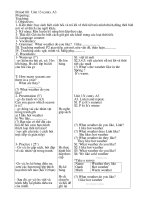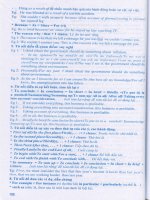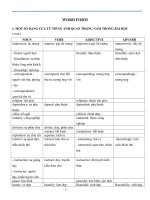Chuyên đề Tiếng Anh 9 - Chuyên đề Reading (phần 5)
Bạn đang xem bản rút gọn của tài liệu. Xem và tải ngay bản đầy đủ của tài liệu tại đây (285.17 KB, 11 trang )
<span class='text_page_counter'>(1)</span><div class='page_container' data-page=1>
<b>Fanpage : </b>
<b>41. Fill in the blank with a suitable word. </b>
Isn’t it amazing how much time we spend (1) about food?
“Have you ever eaten...?” “What did you have for lunch?” and so on. And when
you travel from one country to another, you find that people have quite different
(2) about food. People often feel that what they eat is normal, and
that what other people eat is strange or silly.
In most parts of Asia, for example, no (3) is complete without rice. In
England, people (4) potatoes every day. In the Middle East, bread is the
main part of every meal. Eating, like so many things we do, becomes a (5)
which is difficult to change. Americans like to drink a lot of orange juice and
coffee. The English (6) tea four or five times every day. Australians
drink large amount of beer and the French drink (7) every day.
The sort of meat people like to eat also differs from one country to another.
Horse (8) is thought to be delicious in France. In Hong Kong, some
people enjoy eating snakes. New Zealanders eat sheep, but they never eat goat
meat. The Japanese don’t like to eat sheep meat because of its smell, but they
enjoy raw fish.
So it (9) that although eating is a topic that we can talk about forhours,
there is very little (10) sense in what we say about it. People
everywhere enjoy eating what they have always been earing, and there is very
little we can do to change our eating habits.
<b>42 Choose the word in the box to complete the text. </b>
Vietnamese food culture (1) by regions from the north to the
south. In Northern Viet Nam, Vietnamese food is (2) by light and
<b>sophisticatedly </b> <b>livestock </b> <b>ingredients </b> <b>characterized cuisine </b>
</div>
<span class='text_page_counter'>(2)</span><div class='page_container' data-page=2>
<b>Fanpage : </b>
balanced flavours with the combination of many (3) Northerners
have been using many kinds of meats like pork, beef, and chicken to cook;
besides, some kinds of freshwater fish, crustaceans, and other mollusks like (4)
, crabs, and oysters, etc. Many famous dishes of Viet Nam are cooked with
these ingredients such as Bun Rieu, Pho, Bun Thang, Bun Cha, Banh Cuon, etc.
Then food culture in Central and Southern Viet Nam has developed suitable (5)
in each region. In Central Viet Nam, the regional cuisine of Central
Viet Nam is famous for its spicy food, which differs from two other parts with
mostly non-spicy food. Hue cuisine is typical Central Viet Nam’s food culture.
(6) of Hue cuisine are decorative and colorful, which expresses the
influence of the Vietnamese royal (7) in the feudal period.
Food in the region is often decorated (8) and used with chili peppers
and shrimp sauces, namely, Bun Bo Hue, Banh xeo, or Banh beo, etc.
In Southern Viet Nam, the region is characterized by warm weather and fertile
soil, which creates favorable conditions for planting a variety of fruit,
vegetables and (9) . Thus, food in the region is often added
with garlic, shallots and fresh herbs. Particularly, Southerners are favored of
sugar; they add sugar in most dishes. Here, there is also an (10)
of western and Asian cuisines on southern food, such as influences from
China, India, France, and Thailand.
<b>43. Fill in the blank with a suitable word. </b>
Many health (1) believe that children and young people
todayare more (2) than they used to be. So why has this
happened?
</div>
<span class='text_page_counter'>(3)</span><div class='page_container' data-page=3>
<b>Fanpage : </b>
enough fruit and vegetables. In the US, many children have been eating fast
food (5) sincethey were very young. In fact, almost one-third of
American children aged four to nineteen have been eating fast food (6)
all the time. They also don’t (7) exercise and spend too (8)
of their time watching TV, surfing the Internet or playing computer games.
So how can you change your habits if you have been following an unhealthy
lifestyle for a long time? First, change your (9) and eat more fruit
and vegetables. Next, find an activity you enjoy. Why not try something
different like rock climbing, surfing or hiking? Many young people have found
that (10) fit and healthy can be a lot of fun.
<b>44 Read the following passage and choose the best option for each numbered </b>
<b>blank. </b>
The Maldives are a group of very small islands in the Indian Ocean, near Sri
Lanka. It has the smallest (1) of any Asian countries. There
are about 1200 islands and there are people living on 200 of them. About
400,000 people live in the Maldives and 75,000 of them are (2)
the capital island, Mai... Mai... is different from the other islands in the
Maldives because it doesn’t have any beaches. In fact, there is a small wall (3)
goes around the whole island.
It is very easy to get around the islands. When you (4) on the
airport island, you can take a <i>dhoni</i> and go to Mai... This is a small boat used
for (5) around the islands. <i>Dhoni</i> taxis go from the airport island to the
capital island every fifteen minutes and (6) midnight every
half an hour. You can use these boats to visit other islands, too.
</div>
<span class='text_page_counter'>(4)</span><div class='page_container' data-page=4>
<b>Fanpage : </b>
diving schools with instructors. They speak many languages, so you can (9)
someone to help you. Of course, that’s not all you can do on these beautiful
islands. You can go (10) whale and dolphin, fishing, surfing,
snorkeling, hiking or explore the towns.
1. A. population B. nation C. area D. inhabitant
2. A. in B. on C. above D. at
3. A. who B. where C. it D. that
4. A. depart B. travel C. arrive D. leave
5. A. education B. production C. transportation D. translation
6. A. at B. after C. on D. before
7. A. although B. furthermore C. however D. because
8. A. undersea B. underlevel C. underwater D. Underneath
9. A. find B. see C. look D. hold
10. A. playing B. watching C. hearing D. catching
<b>45. Read the following passage and fill in the blanks with the suitable words in </b>
<b>the box. </b>
Trawl and tourism are very (1) to millions of people over the
world. In every country you (2) find people that work in travel
and tourism. Some countries need the money (3)
</div>
<span class='text_page_counter'>(5)</span><div class='page_container' data-page=5>
<b>Fanpage : </b>
They forget to turn off the (8) or even leave televisions and
air conditioning units on when they leave the room. On top of that, it is often
difficult or impossible (9) travellers to recycle items, so
they end up leaving large amounts of waste behind. That’s (10)
it isimportant for people to travel wisely and respect the places they visit.
<b>46. Read the passage and answer the questions. </b>
In 1761, an artificial waterway opened. It joined a coal-mining area with the
port of Manchester. This was England’s first man-made waterway, or ‘canal’.
Soon the price of coal in this part of the country went down, and the owner of
the Bridgewater canal became rich.
In the late 18th<sub> century landowners and businessmen built many new canals to </sub>
make money. There was no canal plan for the country, but the canals
completely changed the transport of heavy goods in England. Prices of factory
goods went down because transport cost less than before. One horse could now
pull 50 tons on a canal boat. Before, it could pull less than one ton on a road
cart. The canal network was a very important part of the Industrial Revolution
in Britain, but canals had only a short life. In the mid 19th century, the new
railways became the most modern form of transport.
The men who built the canals were called ‘navvies’. They moved around
country in groups from canal to canal. Ordinary people did not like the navvies,
because they wore strange clothes, had no real homes, and because they often
drank too much beer.
</div>
<span class='text_page_counter'>(6)</span><div class='page_container' data-page=6>
<b>Fanpage : </b>
This carried goods from inland factories to the sea. Now it is no longer a
working canal. It is a place for people who like walking or fishing.
1. Why did the price of coal round Manchester decrease?
_______________________________________________________________
2. Why didn’t people like the canal builders?
_______________________________________________________________
3. What did the boats on this canal carry?
_______________________________________________________________
4. Why was the waterway from Midland to Hull important?
_______________________________________________________________
5. Why did the network of canals become less important in a short time?
_______________________________________________________________
<b>47. Choose the word or phrase among A, B, C or D that best fits the blank </b>
<b>space in the following passage. </b>
<b>MY EXPERIENCE ON AN ELEPHANT SAFARI </b>
We went on an elephant safari at a place (1) Camp Jabulani inSouth
Africa. They take visitors on safaris twice a day: once in the morning and once
at night. Guests can go on as many rides as they like, but they don’t (2)
you ride an elephant if you are younger than twelve years old. Luckily, I’m
fifteen! On our first safari, I felt really scared. I remember thinking we could
have gone on a beach holiday instead! As I was climbing onto the elephant, I
wondered how I was going to control (3) a big animal. I soon (4)
</div>
<span class='text_page_counter'>(7)</span><div class='page_container' data-page=7>
<b>Fanpage : </b>
couple of hours because we got (7) just (8) for lunch. We
stayed at Camp Jubalani for three days and went on four elephant safaris. We
could have gone on more than that, but on one of the days my mum wasn’t very
well. Anyway, it was a (9) holiday. I’d definitely (10)
an elephant safari.
1. A. called B. is called C. call D. calling
2. A. want B. make C. let D. allow
3. A. so B. what C. that D. such
4. A. decided B. realized C. recognized D. looked
5. A. on B. by C. with D. for
6. A. taken B. brought C. put D. left
7. A. off B. back C. up D. in
8. A. at times B. late C. in time D. on time
9. A. fantastic B. welcoming C. pleased D. delicious
10. A. demand B. recommend C. suggest D. offer
<b>48. Read the passage, and choose the correct answer A, B, C or D. </b>
Fabrizio from Venice: Of course, there’s a lot to see in Venice. It’s one of the
most famous cities in the world. First of all, there are the canals. We don’t have
cars in Venice so you have to travel everywhere by canal. The most famous
place in Venice is the square. St. Mark’s Square with St. Mark’s Cathedral. And
there are lots of museums and palaces, and beautiful bridges, too.
</div>
<span class='text_page_counter'>(8)</span><div class='page_container' data-page=8>
<b>Fanpage : </b>
Murat from Istanbul: I think Istanbul is maybe the most beautiful city in the
world, but of course I come from Istanbul! The city is built on hills around the
Bosphoros, and so there arebeautiful views across the water. From the water,
you can see mosques – the most famous is called the Blue Mosque – and
palaces and bridges. Istanbul also has a very famous market called the Grand
Bazaar. But these days we also have many modern shopping centres and
modern buildings and hotels. It’s really a fantastic city.
Claudia from Rio de Janeiro: Rio is one of the most exciting cities in South
America ... first of course we have our famous beach, the Copacabana, and
there are many mountains around Rio – the most famous is the Sugar Plum
Mountain where you can see a big statue of Christ, and of course we have our
famous stadium... the Macarana stadium, maybe the most famous football
stadium in the world ... it’s really a great place.
Marina from St. Petersburg: You’ll really love St. Petersburg because there are
so many things to see. The most famous is the Winter Palace, where the Tsars
lived, and the Hermitage Museum which is a fantastic art gallery, and we have a
very beautiful river too, the River Neva, and of course churches and cathedrals.
There is so much to see!
1. The place(s) that Fabrizio recommends coming to in Venice most must be
.
A. the square B. the museums C. the canals D. beautiful bridges
2. All of the following are true about Kyoto EXCEPT that .
A. it is the most beautiful city in Japan
B. it has very good markets and shops
C. the Golden Pavilion is very famous
D. it only has old traditional buildings
</div>
<span class='text_page_counter'>(9)</span><div class='page_container' data-page=9>
<b>Fanpage : </b>
A. the Bosphoros
B. the mosques across the water
C. the Grand Bazaar on the Bosphoros
D. modern shopping centres and buildings
4. We can infer from Claudia’s words that people in Rio .
A. are very religious
B. love architecture
C. love football very much
D. built the statue of Christ on the Copacabana
5. People who would probably want to visit St. Petersburg most are .
A. sports enthusiasts B. art lovers
C. politicians D. ballet dancers
<b>49. Choose the word or phrase among A, B, C or D that best fits the blank </b>
<b>space in the following passage. </b>
When visitors join in a (1) of the Mekong Delta, they can visit Cai Rang
Floating Market to see the river life. Cai Rang Floating Market is (2)
all day but it is busiest from sunrise to about 9 a.m. The main items (3)
there are farm produce and specialties of neighboring areas.
</div>
<span class='text_page_counter'>(10)</span><div class='page_container' data-page=10>
<b>Fanpage : </b>
Activities at the market are also a(n)(9) for tourists to study the
cultural (10) of southerners.
1. A. travel B. trip C. voyage D. tour
2. A. open B. to open C. opened D. opening
3. A. sell B. sold C. selling D. are selling
4. A. no B. bigger C. the same D. smaller
5. A. cry out B. cry C. cry out for D. advertise
6. A. within distance B. in a distance C. in the distance D. by some distance
7. A. so that B. but C. therefore D. although
8. A. how far B. why C. what D. how
9. A. experience B. event C. reason D. occasion
10. A. aspects B. appearances C. guides D. subjects
<b>50 Read the passage carefully, then decide whether the following statements </b>
<b>are true (T) or false (F) </b>
</div>
<span class='text_page_counter'>(11)</span><div class='page_container' data-page=11>
<b>Fanpage : </b>
</div>
<!--links-->
Tài liệu BT TRẮC NGHIỆM TIẾNG ANH 9 GRAMMAR TEST C (UNIT 5+6) docx
- 6
- 1
- 7








